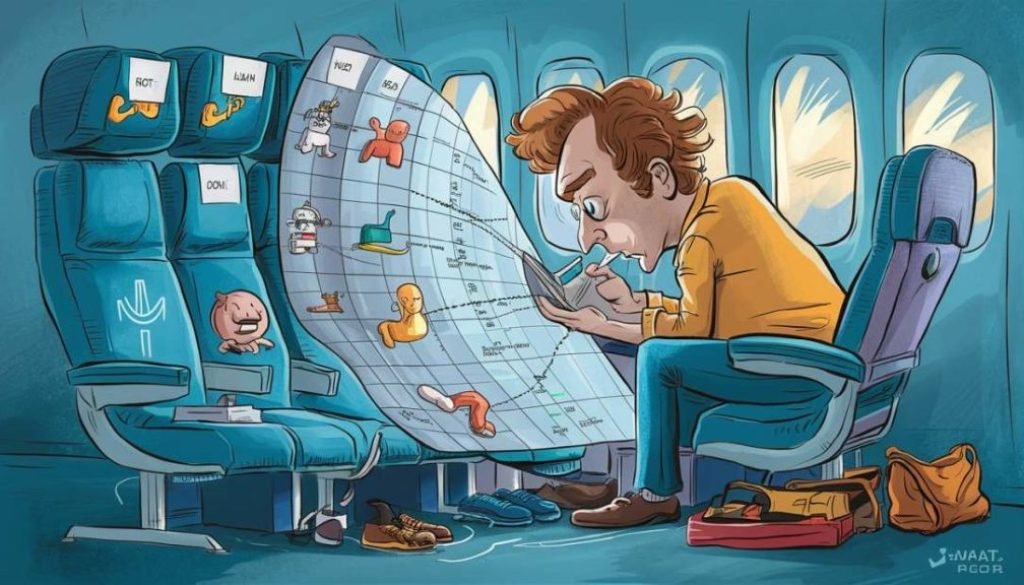What’s the absolute best seat on the plane?
Okay, buckle up, fellow travelers! As your resident airplane and flight expert, I know one question pops up more than almost any other: “What’s the absolute best seat on the plane?”
We all stare at that seat map during booking, wondering where the magic spot is – the one with secret legroom, blissful quiet, and maybe even a forcefield against turbulence (okay, maybe not the last one). The truth is, the “best” seat is subjective and depends heavily on your priorities. But, factoring in both comfort and safety, we can definitely narrow down the top contenders.
Let’s break down the cabin like pros:
The Comfort Equation: What Makes a Seat “Good”?
-
Legroom Champions:
-
Exit Rows: The holy grail for long legs. These seats offer significantly more pitch (the distance between your seat and the one in front).
-
Caveats: You must be willing and able to assist in an emergency. Often, tray tables are in the armrest (slightly reducing seat width), and sometimes under-seat storage is limited. Some exit rows don’t recline.
-
-
Bulkhead Seats: The seats right behind a cabin divider or galley. Also offer great legroom as there’s no seat directly in front.
-
Caveats: No under-seat storage for takeoff/landing (everything must go overhead). Tray tables are in the armrest. Some find the wall restrictive, and these spots can sometimes be bassinet locations (potential for baby noise).
-
-
-
The Quiet Zone Seekers:
-
Seats Towards the Front (Generally): You’re further away from the engine noise (which is mostly behind the wing) and often experience less foot traffic than near the galleys and lavatories at the back.
-
Seats Over the Wing (Sometimes): While engine noise is nearby, you’re often away from the primary galley/lavatory congregation zones found at the very front or back.
-
Avoid: Seats right next to galleys (clatter, chatter, light) and lavatories (odors, noise, queuing passengers).
-
-
Smooth Ride Enthusiasts:
-
Seats Over the Wing: Airplanes pivot around their center of lift, which is near the wings. Theoretically, this area experiences slightly less motion during turbulence compared to the front or (especially) the tail. Think of it like the middle of a seesaw.
-
-
Window Gazers vs. Aisle Access:
-
Window: Best for views (if not over the wing!) and having a wall to lean on for sleep. You won’t be disturbed by neighbors needing the loo.
-
Aisle: Best for easy access to stretch your legs, use the lavatory without climbing over people, and quicker deplaning (especially if near the front). Downside: potential bumps from carts and people.
-
-
Recline Relaxation:
-
Avoid: The last row in any cabin section (often limited or no recline) and sometimes the row before an exit row. Most standard rows offer similar recline.
-
The Safety Factor: Is There a “Safest” Seat?
This is where things get debated, but let’s look at the data and logic:
-
The Official Stance: Airlines and regulators stress that commercial air travel is incredibly safe, and every seat meets stringent safety standards. There’s no single seat guaranteed to be safer in every scenario.
-
Exit Row Advantage (Evacuation): In the rare event of an evacuation, being at an exit row gives you the quickest path out, provided you can operate the door and the exit is usable. This is about getting out fast, not impact survival.
-
The “Rear Seats” Theory (Impact): Some statistical analyses of historical crashes (like the famous TIME magazine study) suggest that passengers seated in the rear third of the cabin, particularly middle seats, had slightly higher survival rates in certain types of severe, survivable crashes. The theory is that the tail can sometimes absorb more impact or break away.
-
Crucial Caveat: This is purely statistical based on past, rare events. It heavily depends on the type of crash. Don’t choose a seat solely based on this if it makes you uncomfortable!
-
-
Structural Integrity: Some argue seats over the wing box (the strongest part of the fuselage) might offer slightly more protection in certain structural failure scenarios, but again, this is highly theoretical in modern aircraft.
So, What’s the Verdict? Combining Comfort & Safety:
-
For Maximum Legroom & Potential Evacuation Speed: An Exit Row Seat (Window or Aisle based on preference) is a strong contender, if you meet the criteria and accept the responsibilities.
-
For a Balance of Quiet, Smooth Ride & Statistical Safety Hint: Seats over the wing or slightly behind it, avoiding the last few rows and proximity to lavatories/galleys. An aisle seat here gives easy access, while a window seat offers rest potential.
-
For Quick Deplaning & Generally Quieter Ride: An Aisle Seat near the front of the cabin (but not bulkhead if you value under-seat storage).
-
Considering Everything (A Practical Compromise): Many frequent flyers settle on an aisle or window seat a few rows behind the front bulkhead but forward of the engines/main galley areas. This often offers a good balance of relative quiet, decent ride stability, and avoids the specific drawbacks of bulkhead/exit/rear rows.
Pro Tips for getting your seat:
-
Book Early: The best seats go fast!
-
Use SeatGuru or AeroLOPA: These websites provide detailed seat maps for most airlines and aircraft types, highlighting seats with extra legroom, limited recline, potential obstructions, or proximity to undesirable areas (galleys/lavs). Check the specific aircraft type for your flight!
-
Consider Airline Status/Fare Class: Elite flyers and those buying premium fares often get free access to preferred seats (including some exit rows or forward cabin seats).
-
Know Your Aircraft: A window seat on a Boeing 737 might have a different view/wing position than on an Airbus A350.
Ultimately, the “best” seat is the one that best suits your needs for that specific flight. Are you prioritizing sleep, work, legroom, or just getting off the plane quickly? Factor in comfort, be aware of the safety nuances (but don’t obsess!), check the seat map tools, and book what feels right for you.
Happy Flying and Smooth Landings!
(What’s YOUR favourite seat? Let us know in the comments below!)




December 2, 2025 @ 3:34 pm
Logging into Arionplay is pretty straightforward with arionplaylogin. Simple and quick, which is exactly what you want when you’re trying to get your game on. arionplaylogin
December 9, 2025 @ 12:26 am
Slotmaxlogin is where it’s at, fam! Easy to login and get straight into the games. No messing around, just pure fun. Definitely recommend giving it a shot. Get logged in at slotmaxlogin!
December 25, 2025 @ 1:03 am
Alright, 777xk, alright! Tried it out on a whim and now I’m hooked. Quick payouts and a decent selection of games. Give it a shot! 777xk
December 29, 2025 @ 5:21 pm
Tigrinhobet, meu camarada! Achei um site show de bola pra dar uns palpites. Fácil de usar e as odds são daquelas que enchem o bolso! Vale a pena conferir tigrinhobet.
December 29, 2025 @ 11:11 pm
Put in a little time on lucky47 the other night. Simple, straight to the point and a refreshing change of pace. Definitely worth a little peak: lucky47
January 5, 2026 @ 7:05 am
Tai Poker King? Now that’s a name! If you’re serious about poker, you gotta check this place out. Might find some good competition and sharpen your skills. Get dealt in at: taipokerking